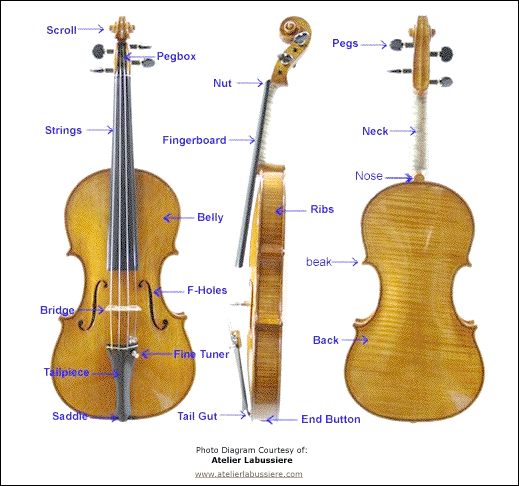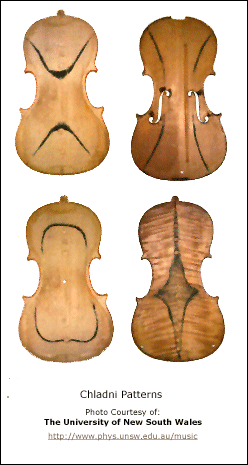Farisha Salman was studying Computer Science at the University of Southern California in the fall of 2005. She enjoys dancing and playing musical instruments in her free time and is a passionate student of the Korean language.
The violin is regarded as one of the most important musical instruments in history, perhaps because of its fundamental role in an orchestra or the inspiration and emotion transferred to the listener upon hearing its powerfully romantic sound. While its construction concentrates on producing impeccable sound, had the violin not adhered to the laws of science, it would have been a failure as a musical instrument (Hughes). Indeed, the violin is an amazing amalgam of science, mathematics, physics, and chemistry but it is strictly regulated by physical and acoustic laws. Nothing about the violin can be changed without seriously disturbing its equilibrium as an instrument of essential and precise assimilation.
The History of the Violin
The history of the violin can be traced back as far as the 9th century. Although violin-playing is best known in European countries, especially considering the origins of world famous violinists like Fritz Kreisler, Jascha Heifetz, and Niccolo Paganini, violins are believed to have originated in Asia [1]. The current form of the violin, however, evolved more than 500 years ago from several musical instruments. These precursors include rudimentary instruments called the Rebab, Rebec, and Ravanastron, played in Iran, Saudi Arabia, and India. The Rebec, a pear-shaped instrument, contributes some of its traits to the modern violin. Positioned at the neck and played with a bow like the violin, the Rebec has f-holes carved out from its body. In addition, like the violin, the strings of the Rebec are secured and tightened by pegs laterally inserted into a pegbox [2].
The Major Components of the Violin
The violin is composed almost entirely of wood. It is shaped like a woman’s body by design and has a bridge that is placed between the two f-holes (Fig. 1). Four strings, connected to a saddle, are positioned on the bridge, extended across the fingerboard, and tied into a pegbox at the opposite end. These strings can be metal, gut or a hybrid called synthetic core. Also, two f-holes are carved out from the body of the violin and at the end of the finger board, a scroll protrudes from the pegbox.
The violin contains distinct components and understanding how each of these parts is connected to the violin as a whole is crucial. The major parts of the violin– the body, bridge, strings and bow– each contribute to the production of a violin’s distinct sound.
The Major Components of the Violin
The Body
There are four types of wood that generally make up the body: spruce, maple, ebony, and rosewood. The quality of wood used is important because flexible wood tends to shape well and projects the highest quality of sound. A good wood will have been aged or air-dried in order to have the optimal moisture equilibrium with the environment. Wood lacking this quality will often be inflexible and crack during shaping, or worse, playing.
The violin maker selects only the best trees by tapping the trunk with a hatchet to determine if that particular tree’s wood will produce quality sound. Once the tree has been chopped down, it is stored in a ventilated place protected from seasonal change for as long as 20 years. In general, the wood chosen must be light in order to emit melodious sounds through decent resonant vibrations. In fact, heavier wood would actually thwart the energy essential to create quality sound. But at the same time, the wood must be strong enough to withstand the concentrated pressure exerted by its four strings on the bridge, which can be as high as 250 Newtons or 17 lbs.
After the rigorous selection process, the wood is carved into two symmetrical plates, the upper and lower bodies, each painstakingly shaped to exhibit what are called “Chladni Patterns.” The importance of this technique is to observe the mode shapes, different patterns formed on a violin when different frequencies are applied to it. These patterns can be tested by using a loudspeaker to vibrate the bodies and observing the patterns formed by some black sand sprinkled onto the plates; resonance induces enough motion over the plates to cause the sand to bounce about [3]. “Chladni Patterns” (Fig. 2) are useful as they indicate whether the wood must be further shaped or thinned, with a thinner plate resulting in more pronounced pattern response. As the pattern must be very exact, final adjustments must be made by a very skilled craftsman, one who knows how each subtlety in the patterns will affect the final sound of the violin.
The Major Components of the Violin
The Bridge
While precisely shaped plates do contribute significantly to the sound produced by a violin, the bridge (Fig. 3), though small in size, has vast effect on the transfer of the sound to these wooden plates. In fact, the bridge is so important in sound production that it is often referred to as the heart of the violin.
The bridge serves two purposes. It holds the strings; but more importantly it transfers vibrations from the strings to the belly, which then transmits those vibrations to the body through the sound post and the bass bar. Since the bass bar and the sound post are connected to the bridge, they also vibrate and in turn rock the belly, causing the whole violin to vibrate. This complete vibration induces waves in the air inside the violin, thereby changing the original vibration caused by the strings into sound that is emitted through the f-holes and…Voila! The violin produces its beautiful, familiar sound. Interestingly, the bridge transmits power to the body at frequencies from about one to four kHz, the range at which the ear is most sensitive. Thus the bridge, although very small relative to other parts of the violin, contributes a great deal in sound and timbre to the violin.
It is important to remember that the placement of the bridge is equally important in the construction of a violin. It should be placed exactly between the fingerboard and the tailpiece vertically, while perfectly horizontal between the two f-holes. This is to ensure that the violin, if played correctly, produces the ideal sound. Moving the bridge even a centimeter from its optimal position can change the overall sound of the violin. To better understand this consequence, think of the bridge like a rubber band held taut between two fingers. Strum on it, and it makes a particular sound. However, if you stretch the rubber band and strum on it again, a higher frequency sound is produced. Similarly, changing the position of the bridge could disrupt the desired sound of a violin.
Finally, the type of bridge used depends on the strings selected. A violin needs a high bridge for low tension gut core strings or a low bridge for tighter metal or synthetic strings. The reason behind this is that metal strings are harder to bow because they require higher tension than gut core stings. But since tension is needed to produce good sound, yet not much should be added if metal strings are used, the lower bridge comes in handy. A low bridge has less tension than a high one, which helps to maintain the perfect tension needed in producing quality sound.
The Interactions between String and Bow
The importance of choosing the right strings for a violin can be compared to selecting tires for a car. Just like poorly made tires can result in a squeaky ride, selecting low quality strings will likewise yield cacophonous noises when a violinist attempts to stroke the strings.
Each string on a violin is responsible for a distinct note. The E string, the highest note, is usually made of metal because metal has the highest tension and is capable of producing the highest frequency sound. On the other hand, the G string — the lowest note — is made of gut core string that has far less tension than metal and produces low frequencies. To play the violin, the bow, which is composed of horse hair stretched across a long strip of wood, is pulled across the strings. Horse hair is used because of its electrostatic qualities. It acts like a magnet, attracting particles of rosin that help stick the bow to the strings. The more the bow is “glued” to the strings, the richer the sound it will produce. The friction between the hair and the strings causes the strings to vibrate and generate sound waves.
To the naked eye, the string appears as though it is moving back and forth, but in actuality it is moving in a V-shape. This observation was first discovered by Hermann von Helmholtz 140 years ago, and since then violinists have tried to achieve the “Helmholtz Motion,” where “smooth playability and good tone” of a bowed-string instrument are accomplished. Helmholtz motion is characterized by the bow stroking the string and creating a single corner or indentation in the string that travels back and forth on the string with an slightly parabolic structure, or envelope. The corner then sticks to the bow as they touch one another. While the corner is on the shorter part of its journey, between the bow and the bridge, the string slips under the bow [4].
The Finale
Imagine that you are seated in a dark hall. Suddenly the hall lights up and people around you start applauding madly. The woman on stage is proudly displaying a violin. She is none other than Midori Goto, a child prodigy. Then the lights dim and the audience takes their seats. Midori starts playing slowly at first, but then her bow begins to move so fast that you would think it was going to fly out of her hand at any given moment. In the corner of the hall, you gaze in awe as she mesmerizes you with the awe-inspiring sound that comes from her teeter-tottering bow. It is indeed amazing how one thin piece of wood can produce such incredible sounds when it touches the violin strings. Although the sounds are beautifully intangible, the phenomenon of this musical instrument can reveal itself through the examination of the brilliant engineering behind it.
References
[1] Cyril Benoit, et al. “Violin: Origin.” Internet: http://library.thinkquest. org/27178/en/section/1/, 1999 [1 Apr. 2005].
[2] David D. Boyden. The history of Violin Playing from its Origins to 1761and Its Relationship to the Violin and Violin Music.New York: Oxford University Press, 1990.
[3] John Smith and John Tann, et al. “Chladni Patterns for Violin Plates.” Science@UNSW. Internet: http://www.phys.unsw.edu.au/~jw/chladni.html, 2004 [2 Apr. 2005].
[4] Stefania Serafin, Smith III, and Julios O., et al. “An Investigation of the Impact of Torsion Waves and Friction Characteristics on the Playability of Vitual Bowed Strings.” IEEE Workshop on Applications of Signal Processing to Audio and Acoustics. Internet: http://www-ccrma.stanford.edu/~serafin/SerafinEtAl.pdf, pp. 17-20, Oct. 1999 [2 Apr. 2005].
[5] Frederick Bueche. Principles of Physics. 3rd ed. New York: McGraw-Hill, 1977.
[6] Carl Courvoisier. Technics of Violin Playing on Joachim’s Method. London: E. Shore and Co., 1899.
[6] Lothar Cremer. The Physics of the Violin. Trans. John S. Allen. Cambridge, Mass.: MIT Press, 1984.
[7] Kristi Ann Hughes. “The History of the Violin.” Internet: http://www.fresno-violin-lessons.com/violin_history/index.asp., 28 Dec. 2004 [1 Apr. 2005].






